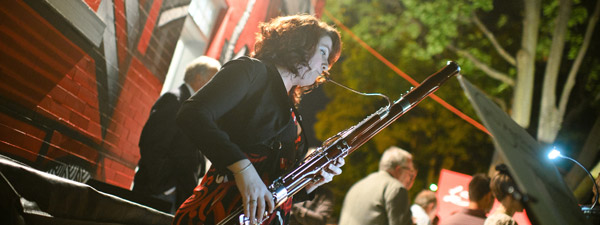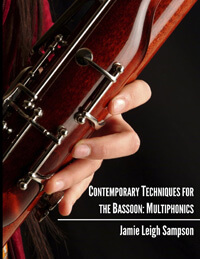Jamie Leigh Sampson wears enough hats to open her own millinery shop. An active new music bassoonist, composer, and entrepreneur, on April 12, 2014, she added “author” to that list with publication of her first book, Contemporary Techniques for the Bassoon: Multiphonics.

Jamie Leigh Sampson
Bassoon multiphonics seems like a thorny topic; how did you decide to write a book about it?
Sofia Gubaidulina’s Duo Sonata for two bassoons first sparked my interest in multiphonics when I was an undergraduate student at SUNY Fredonia. After I heard it, I ordered the score and started digging into Sergio Penazzi’s Metodo per Fagotto, to find more multiphonic fingerings. It wasn’t until the first semester of my graduate studies at Bowling Green that I even considered creating my own resource. I was writing a solo bassoon piece while studying with Burton Beerman, and we had a discussion about the problems associated with the existing bassoon multiphonic resources. All of the books and articles that I saw had only tested the fingerings on one or two instruments. Bassoons have a lot of variation from one instrument to the next (e.g., different bore dimensions, bocals, reed styles, etc.), and testing with a narrow field of bassoons does not give composers or performers a complete enough picture of the instrument’s multiphonic capabilities. At one point during our discussion, Dr. Beerman said, “Someone should write a new multiphonic book for bassoons. You could do it.” I laughed it off at the time, but about six months later it was all I could think about. My initial plan was to put together a compendium of multiphonics that I could play, which I would share with the composers I collaborate with. The project grew from there into a resource for all bassoonists and composers.
Subscribe to our Week in Review and win a copy of Jamie Leigh Sampson! This week only!
So what is in the book and how can composers and performers use it?
Contemporary Techniques for the Bassoon: Multiphonics is a collection of 271 multiphonic fingerings, with descriptions of how to perform them, notation suggestions, pitch content, and the dynamic ranges for each. I worked with twenty bassoonists from around the country to test each fingering on their instruemnts. These bassoonists ranged in age, experience, and specialty, which helped ensure that each fingering included in this resource was reliable across a variety of instruments and performers. The book includes an appendix where multiphonic fingerings are categorized by prominent pitch, so composers can quickly find multiphonics with similar pitch content. Bassoonists will not only find the fingerings they’ll need to perform multiphonics within the current and future repertoire, but also helpful advice and suggestions, collected from the participating bassoonists, about how to easily produce them.

Jamie Leigh Sampson, author of Contemporary Techniques for the Bassoon: Multiphonics (photo: ADJ•active New Music, LLC)
You are also an active composer; what is your aesthetic, what drives you?
I have been incredibly fortunate over the past few years to work with dynamite performers from the Ogni Suono Saxophone Duo, Ensemble Dal Niente, and the Quince Contemporary Vocal Ensemble. This year, I’m looking forward to completing two trios (one for the Aurea Silva trio, the other for mezzo-soprano Kayleigh Butcher) and a one-act chamber opera. Writing the multiphonic book demanded all of my focus through 2013, so I am very excited to be working on these new compositions; it is a refreshing change of pace.
I am greatly influenced in my composing by the written word. I prefer to have an element of text linked to each of my works. Even if there isn’t a vocal part, there is typically a poem, quote, or passage of prose behind each composition. In particular, the books and short stories of Iréne Némirovsky and Ian McEwan inspire me. They explore the immediate aftermath of some of life’s most devastating situations and the volatile emotions that erupt and subside with each occurrence. I aim to musically capture and explore those types of emotions.
What is your focus as a performer in the ADVerb ensemble and as a soloist?
ADVerb is a trio d’anches that I perform in with my husband, clarinetist/composer Andrew Martin Smith, and oboist Sipkje Pesnichak. Sipkje and I have been performing together since we were teenagers in the Syracuse Symphony Youth Orchestra. We then attended SUNY Fredonia for our undergraduate studies, where we met Andrew. We performed together in a variety of chamber ensembles, and formally organized as a trio in 2011. As a trio we specialize in music of the early Twentieth-century and newly commissioned works, but we also play the occasional holiday church service and wedding.
As a soloist, I am really looking forward to collaborations that stem from the book. I recorded my own piece, Frozen Landscape, for Beauport Classical in 2008, and I am developing a new recording project for the near future.
You and Andrew are cofounders ADJ•ective New Music, LLC; what is your entrepreneurial focus?
 ADJ•ective is one of the most exciting endeavors I have undertaken. It began as a way to manage all of the activities, income, and expenses that Andrew and I have as composers, but it quickly grew into a much larger enterprise. We each have private studios (with students studying performance, composition, and theory). We also produce a concert series— going into its fourth season—that lives in the art galleries and small venues in Toledo (OH). We have worked with many composers and performers throughout the region to offer a unique concert experience for our area. Additionally, we publish our own scores and contemporary music resources, like the new book.
ADJ•ective is one of the most exciting endeavors I have undertaken. It began as a way to manage all of the activities, income, and expenses that Andrew and I have as composers, but it quickly grew into a much larger enterprise. We each have private studios (with students studying performance, composition, and theory). We also produce a concert series— going into its fourth season—that lives in the art galleries and small venues in Toledo (OH). We have worked with many composers and performers throughout the region to offer a unique concert experience for our area. Additionally, we publish our own scores and contemporary music resources, like the new book.
The next step for ADJ•ective is to get more composers involved. We believe it’s in composers’ best interest to self-publish their work at this point in time, so we’re looking for new ways to include others. We’re still discussing the possibilities and what will work best, so I can’t say much more yet. Suffice it to say we’re planning a long road for ADJ•ective with a lot of exciting projects along the way.























